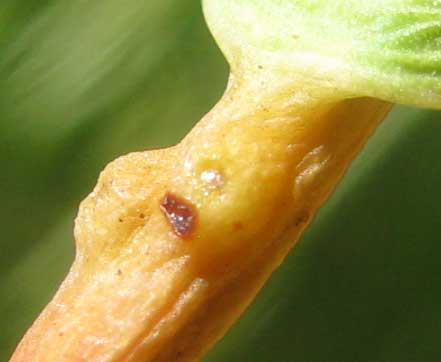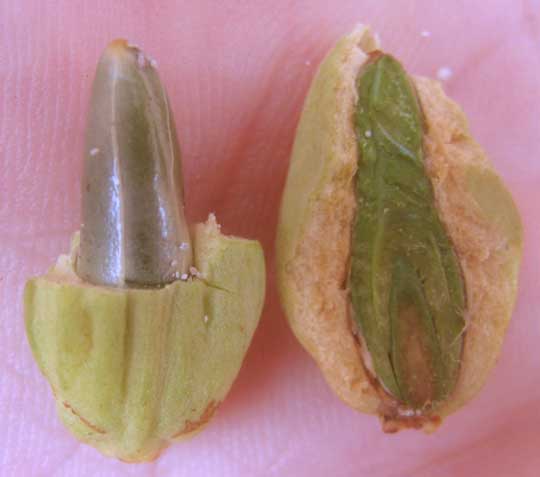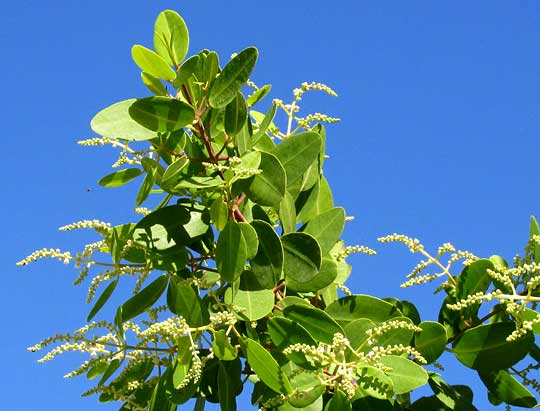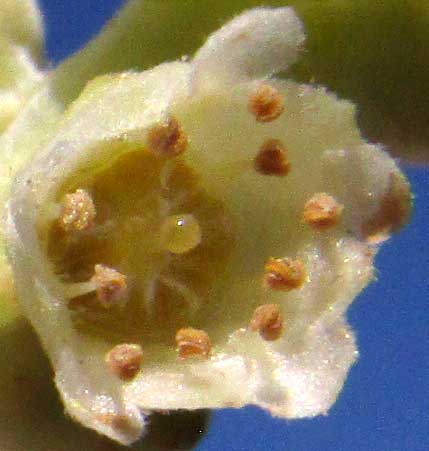Excerpts from Jim Conrad's
Naturalist Newsletter

from the October 2, 2011 Newsletter issued from Mayan Beach Garden Inn 20 kms north of Mahahual; Caribbean coastal beach and mangroves, ~N18.89°, ~W87.64°, Quintana Roo state, MÉXICO
WHITE MANGROVE
In our part of the world four tree species are regarded as mangrove indicators: Red Mangrove, Black Mangrove, White Mangrove and Buttonwood. In mangroves along the Yucatán's northern coast I've seen all four species commonly growing.
However, here 20 kms north of Mahahual on the southeastern coast, until this week I'd found only two of those four mangrove species. In deeper water and where water stands for longer periods there's the Red Mangrove, distinguished by its flaring "stilt roots" and fruits that germinate daggerlike roots while still hanging on the tree. At the water's edge or on dry land where the water table lies very close to the surface, you find the second mangrove species, Buttonwood, abundantly bearing pea-sized, cone-like fruits.
This week I found a small population of a third species, White Mangrove, LAGUNCULARIA RACEMOSA, a member of the mostly tropical Combretum Family. From just a few feet away, dense and much-branching White Mangrove looks like a green wall, but up close you begin seeing distinguishing features such as its three-inch-long (7cm) leaves with rounded or notched tips, and long, roundish petioles jutting from the stem almost at right angles. Also there are clusters of half-inch-long, thick-ribbed, leathery, roughly wedge-shaped fruits. All this is shown on a branch at the top of this page.
At the top of many of the stiff petioles there are two wartlike glands such as those seen below:

In other species often such glands exude chemicals that attract ants which protect the leaves from leaf eaters, or maybe the glands produce chemicals that themselves repel leaf-eating insects. I read that the White Mangrove's petiole glands help the plant excrete excess salt, but I also read that instead of excreting salt they attract insects with a sweet exudate. I think the concensus is trending toward the last idea. Also I read that White Mangroves discard salt when they drop their thick, succulent leaves, supporting the notion that the petiole gland have to do with insects.
Last week we saw that Red Mangrove's seeds germinate while the fruits still are attached to the stems -- the seeds are "viviparous." That's advantageous for wetland trees where seeds can root and begin growing as soon as they fall. With a White Mangrove fruit in hand, I wondered if it might do something similar. You can see a fruit, crowned by the former flower's calyx, below:

A fruit with its top broken off, and another fruit with one side stripped away, are shown below:

The dark green item inside the fruit is the sprout's future green leaves wrapped around one another. In typical seeds we'd find a small, hardly noticeable embryo that would remain dormant for a season but here we have a living shoot that once it's formed never stops developing inside the fruit on or off the tree. This green-leafed shoot will have a head start rooting and growing as soon as the seed is deposited on mud or in water. Since the seeds aren't germinating while still on the tree they're not viviparous like those of the Red Mangrove, but some experts would say that the White Mangrove's seeds are "semi-viviparous."
Our White Mangroves are only about eight feet tall (2.5m) but I read that in Mexico they may grow up to 60 feet tall (18m).
Why are White Mangroves so rare in this particular area? It may have something to do with Marcia's observation that before the 2007 super-Hurricane Dean, the fourth mangrove, Black Mangrove -- the one with slender, pale, witch's-fingers-like "pneutamophores" rising from the water to absorb air for the tree -- was common here, but now it's not to be seen.
from the June 7, 2015 Newsletter issued from Río Lagartos, on the Yucatan Peninsula's northern coast (~N21.60°, ~W88.16°), Yucatán state, MÉXICO
WHITE MANGROVE FLOWERING
Nowadays our White Mangroves are prolifically producing spreading panicles of tiny flowers along branches and at their tips, as shown below:

Up close, the 5mm-tall flowers (3/16ths inches) look like short-stemmed, whitish goblets, as shown below:

A closer look inside one of the interesting flowers is provided below:

The ten stamens are inserted on the calyx -- not on the corolla -- at two different levels. The ovary is " inferior," or below the calyx and corolla. At the bottom of the cup formed the alternating five petal-like sepal lobes and five roundish petals there's a flatish, doughnut-like "disc" from the center of which arises the style topped with its shiny stigma. Most flowers don't have such discs. Up north we don't see many flowers with such a combination of features because White Mangrove is a member of the tropical and subtropical Combretum Family, the Combretaceae, a family little known by northern gardeners and wildflower lovers.
Before the rains came, lines of black ants could be seen constantly moving up and down the White Mangrove's stems, going for nectar.